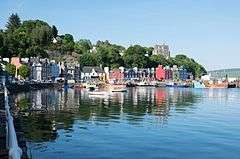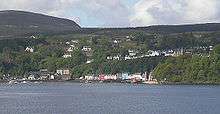Tobermory, Mull
| Tobermory | |
| Scottish Gaelic: Tobar Mhoire [1] | |
 Tobermory waterfront |
|
 Tobermory |
|
| Population | 980 [2] |
|---|---|
| OS grid reference | NM504551 |
| Council area | Argyll and Bute |
| Lieutenancy area | Argyll and Bute |
| Country | Scotland |
| Sovereign state | United Kingdom |
| Post town | ISLE OF MULL |
| Postcode district | PA75 |
| Dialling code | 01688 |
| Police | Scottish |
| Fire | Scottish |
| Ambulance | Scottish |
| EU Parliament | Scotland |
| UK Parliament | Argyll and Bute |
| Scottish Parliament | Argyll and Bute |
Coordinates: 56°37′N 6°04′W / 56.62°N 6.07°W
Tobermory (/ˌtoʊbərˈmɔəri/; Scottish Gaelic: Tobar Mhoire), or Balamory, is the capital of, and the only burgh on, the Isle of Mull in the Scottish Inner Hebrides. It is located in the northeastern part of the island, near the northern entrance of the Sound of Mull. With a current population of approximately 700, the town was founded as a fishing port in 1788, its layout based on the designs of Dumfriesshire engineer Thomas Telford.
Etymology
The name Tobermory is derived from the Gaelic Tobar Mhoire, meaning "Mary's well".[3][4] The name refers to a well located nearby which was dedicated in ancient times to the Virgin Mary.[5]
History
Legend has it that the wreck of a Spanish galleon, laden with gold, lies somewhere in the mud at the bottom of Tobermory Bay – although the ship's true identity, and cargo, are in dispute. By some accounts, the Florencia (or Florida, or San Francisco), a member of the defeated Spanish Armada fleeing the English fleet in 1588, anchored in Tobermory to take on provisions. Following a dispute over payment (or possibly, according to local folklore, a spell cast by the witch Dòideag), the ship caught fire and the gunpowder magazine exploded, sinking the vessel. In her hold, reputedly, was 300,000 GBP worth of gold bullion.[6] Other sources claim the vessel was the San Juan de Sicilia (or San Juan de Baptista), which, records indicate, carried troops, not treasure.[7][8][9] Whatever the true story, no significant treasure has ever been recovered in Tobermory Bay.[10] The largest attempt made to locate the galleon was in 1950 when the then Duke of Argyll signed a contract with the British Admiralty to locate the galleon. Nothing came of the attempt, apart from the development of equipment still used today to locate ancient sunk vessels.[11]
Due to similarities in sailing conditions, in the mid-1800s emigrant sailors created the community of Tobermory, located in Ontario, Canada. This namesake town has twin harbours, known locally as "Big Tub" and "Little Tub", which sheltered ships from the severe storms of Lake Huron. Big Tub Harbour is Canada's largest natural freshwater harbour. There are numerous shipwrecks nearby so it is a thriving SCUBA diving destination.
During World War II, Tobermory was home to Royal Navy training base HMS Western Isles under the command of the legendary Vice-Admiral Sir Gilbert Stephenson. The so-called Terror of Tobermory's biography was written by broadcaster Richard Baker, who trained under him.[12][13]
Attractions

Many of the buildings on Main Street, predominantly shops and restaurants, are painted in various bright colours, making it a popular location for television programmes, such as the children's show Balamory. The burgh hosts the Mull Museum, the Tobermory whisky distillery (and from 2005 to 2009 there was also a brewery, the Isle of Mull brewing company)[14] as well as Mull Aquarium, the first catch and release aquarium in Europe.[15] The clock tower on the harbour wall is a noted landmark. The town also contains an arts centre An Tobar, the management of which was merged with Mull Theatre in 2012 to form the umbrella arts organisation Comar. [16] The theatre remains based just outside Tobermory in Drumfin and is used by youth and adult dance and drama groups, hosting a wide variety of performances.[17]
71 % of Tobermory residents were born in Scotland, 23 % in England and 6 % elsewhere.[2]
Tobermorite, a calcium silicate hydrate found near Tobermory in 1880 was named after the town.[18]
Notable residents



Tobermory's most notable expat is arguably Gordon Buchanan – famed wildlife Camera Operator and Presenter. The towns many other famous sons and daughters include Duncan MacGilp and Janet MacDonald, both past Gold Medal winners at Scotland's Royal National Mòd. Three generations of the town's MacIntyre family have achieved eminence: Colin MacIntyre is a singer songwriter. His brother is BBC Scotland Sport's Kenny Macintyre, and his late father, also called Kenny, was BBC Scotland Political Correspondent while his grandfather was the so-called Bard of Mull, poet Angus MacIntyre. The late accordionist Bobby McLeod lived in the town from his birth in 1925 until his death in 1991, and owned the Mishnish Hotel.
Another Tobermory native was Donald McLean (1805–1864), who emigrated to Canada before he was twenty and became a fur trader and explorer for the Hudson's Bay Company in the New Caledonia and Columbia Department fur districts, rising to the position of Chief Trader at Thompson's River Post (Fort Kamloops) in the then-Colony of British Columbia. He was the last casualty of the Chilcotin War of 1864; his "halfbreed" sons were known as the Wild McLean Boys and were tried and hanged for murder.[19]
Isabella Bird, the famous Victorian traveller and writer frequently stayed in the town where her sister Henrietta had a house. She often assisted the local doctor and, on at least one occasion, served as anaesthetist when he removed a tumour from a local woman. When Henrietta died she funded the building of the clock tower as a memorial to her beloved sister. [20]
Annual events
The visit of the composer Felix Mendelssohn in 1829, en route to Staffa, is commemorated in the annual Mendelssohn on Mull Festival in early July.[21] Other highlights of the town's calendar include an annual Traditional Music Festival held on the last weekend in April, the local Mòd, which takes place on the second Saturday in September and has established itself as one of the best local Mòds on the circuit, the Mull Fiddler's Rally also in September, and the traditional Mull Highland Games held every summer.
Literary associations
The fictional town of Torbay in Alistair MacLean's novel When Eight Bells Toll was based on Tobermory, and much of the 1971 movie was filmed in the town and other parts of Mull. The writer Saki gave the name to a talking cat in one of his most famous short stories and two well-loved children's TV series have made use of the town's name. Elisabeth Beresford called one of the Wombles Tobermory and, more recently, the town played host to its almost-namesake Balamory for 3 years (2002–2005). Other films made in the area include the 1945 Powell and Pressburger classic I Know Where I'm Going!.
In the children's animated feature, Nocturna, the Cat Shepherd's faithful cat, is called Tobermory.
Transport
Ferries sail between Tobermory and the mainland to Kilchoan on the peninsula of Ardnamurchan, but principal access to the island is via ferry between Oban and Craignure. Craignure is some 22 miles from Tobermory. This is the main route for visitors to the island. An additional ferry route is between Lochaline on the mainland to Fishnish.
References
- ↑ "Details". Ainmean-Àite na h-Alba ~ Gaelic Place-names of Scotland. Retrieved 31 December 2014.
- 1 2 "Comparative Population Profile: Tobermory Locality Scotland". SCROL. Retrieved 31 December 2014.
- ↑ "Guide to Gaelic origins of place names in Britain" (PDF). Ordnance Survey. Nov 2005. Retrieved 1 September 2006.
- ↑ "A Guide to the Meaning of Gaelic Distillery Names". 2003. Archived from the original on 13 August 2006. Retrieved 1 September 2006.
- ↑ Lewis, Samuel (1846). Topographical Dictionary of Scotland: Tain – Tobermory. Institute of Historical Research. pp. 526–46.
- ↑ "A Clan Feud, a Spanish Galleon, and a Big Bang". lostfort.blogspot.com. Retrieved 10 July 2010.
- ↑ "The Galleon San Francisco". shipmodeling.net. Retrieved 10 July 2010.
- ↑ "The Tobermory Wreck". The Scotsman. Retrieved 10 July 2010.
- ↑ "British Archaeology Magazine – Guns of the Armada – Colin Martin". 2002. Retrieved 29 July 2008.
- ↑ "Tobermory Bay". reese.org. Retrieved 10 July 2010.
- ↑ "Preliminary Search for Treasure in Tobermory Bay". Popular Mechanics (October 1950): 160–162.
- ↑ Baker, Richard (1972). The Terror of Tobermory: Vice-Admiral Sir Gilbert Stephenson, KBE, CB, CMG. W.H. Allen. p. 196. ISBN 978-1-84158-197-2.
- ↑ Baker, Richard (2005). The Terror of Tobermory. Edinburgh: Birlinn. ISBN 978-1-84341-023-2. Paperback edition of the above biography of Vice Admiral Sir Gilbert Stephenson KBE CB CMG and history of HMS Western Isles
- ↑ "Isle of Mull Brewing Company". Today's Breweries. ScottishBrewing.com. Retrieved 17 August 2016.
- ↑ "Mull Aquarium". Mull Aquarium. Retrieved 5 November 2015.
- ↑ "Mull public meeting on Comar mess: a rout ending in An t-Eilean Muileach". Argyll News. Retrieved 2 January 2016.
- ↑ "music, visual arts & theatre". Comar. Retrieved 16 March 2013.
- ↑ "Tobermorite". mindat.org. Retrieved 24 July 2010.
- ↑ "McLEAN, DONALD". Dictionary of Canadian Biography Online. Retrieved 31 December 2014.
- ↑ Stoddart, Anna (1906). The life of Isabella Bird : (Mrs Bishop). Murray. ISBN 9781169984554.
- ↑ "Mendelssohn on Mull Festival". Mendelssohn on Mull Festival. Retrieved 2 November 2009.
External links
| Wikimedia Commons has media related to Tobermory. |
